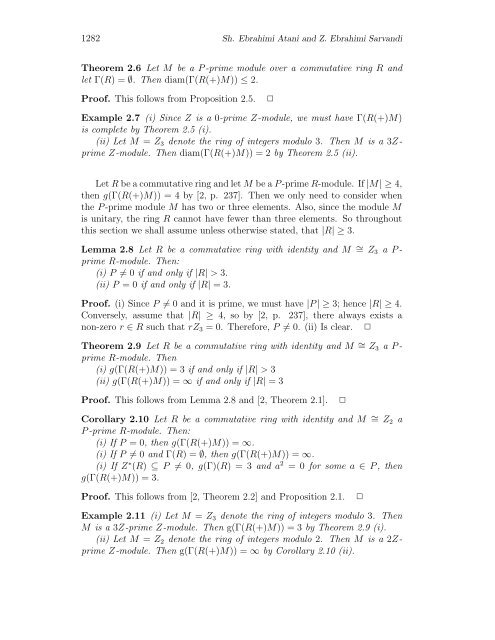Zero-Divisor Graphs of Idealizations with Respect to Prime Modules ...
Zero-Divisor Graphs of Idealizations with Respect to Prime Modules ...
Zero-Divisor Graphs of Idealizations with Respect to Prime Modules ...
You also want an ePaper? Increase the reach of your titles
YUMPU automatically turns print PDFs into web optimized ePapers that Google loves.
1282 Sh. Ebrahimi Atani and Z. Ebrahimi Sarvandi<br />
Theorem 2.6 Let M be a P -prime module over a commutative ring R and<br />
let Γ(R) =∅. Then diam(Γ(R(+)M)) ≤ 2.<br />
Pro<strong>of</strong>. This follows from Proposition 2.5. ✷<br />
Example 2.7 (i) Since Z is a 0-prime Z-module, we must have Γ(R(+)M)<br />
is complete by Theorem 2.5 (i).<br />
(ii) Let M = Z3 denote the ring <strong>of</strong> integers modulo 3. Then M is a 3Zprime<br />
Z-module. Then diam(Γ(R(+)M)) = 2 by Theorem 2.5 (ii).<br />
Let R be a commutative ring and let M be a P -prime R-module. If |M| ≥4,<br />
then g(Γ(R(+)M)) = 4 by [2, p. 237]. Then we only need <strong>to</strong> consider when<br />
the P -prime module M has two or three elements. Also, since the module M<br />
is unitary, the ring R cannot have fewer than three elements. So throughout<br />
this section we shall assume unless otherwise stated, that |R| ≥3.<br />
Lemma 2.8 Let R be a commutative ring <strong>with</strong> identity and M ∼ = Z3 a P -<br />
prime R-module. Then:<br />
(i) P = 0if and only if |R| > 3.<br />
(ii) P =0if and only if |R| =3.<br />
Pro<strong>of</strong>. (i) Since P = 0 and it is prime, we must have |P |≥3; hence |R| ≥4.<br />
Conversely, assume that |R| ≥ 4, so by [2, p. 237], there always exists a<br />
non-zero r ∈ R such that rZ3 = 0. Therefore, P = 0. (ii) Is clear. ✷<br />
Theorem 2.9 Let R be a commutative ring <strong>with</strong> identity and M ∼ = Z3 a P -<br />
prime R-module. Then<br />
(i) g(Γ(R(+)M)) = 3 if and only if |R| > 3<br />
(ii) g(Γ(R(+)M)) = ∞ if and only if |R| =3<br />
Pro<strong>of</strong>. This follows from Lemma 2.8 and [2, Theorem 2.1]. ✷<br />
Corollary 2.10 Let R be a commutative ring <strong>with</strong> identity and M ∼ = Z2 a<br />
P -prime R-module. Then:<br />
(i) If P =0, then g(Γ(R(+)M)) = ∞.<br />
(i) If P = 0and Γ(R) =∅, then g(Γ(R(+)M)) = ∞.<br />
(i) If Z ∗ (R) ⊆ P = 0, g(Γ)(R) =3and a 2 =0for some a ∈ P , then<br />
g(Γ(R(+)M)) = 3.<br />
Pro<strong>of</strong>. This follows from [2, Theorem 2.2] and Proposition 2.1. ✷<br />
Example 2.11 (i) Let M = Z3 denote the ring <strong>of</strong> integers modulo 3. Then<br />
M is a 3Z-prime Z-module. Then g(Γ(R(+)M)) = 3 by Theorem 2.9 (i).<br />
(ii) Let M = Z2 denote the ring <strong>of</strong> integers modulo 2. Then M is a 2Zprime<br />
Z-module. Then g(Γ(R(+)M)) = ∞ by Corollary 2.10 (ii).
















